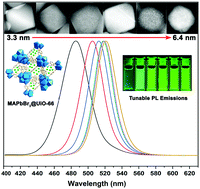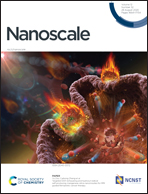In situ confined growth of ultrasmall perovskite quantum dots in metal–organic frameworks and their quantum confinement effect†
Abstract
The metal halide perovskite quantum dots (APbX3 PeQDs; A = Cs or CH3NH3; X = Cl, Br or I) have emerged as a new type of promising optoelectronic material for light-emitting and photovoltaic applications because of their excellent optical properties. However, the precise control over the size and photoluminescence (PL) emission of APbX3 PeQDs remains a great challenge, which has been one of the main obstacles to the applications of PeQDs. Herein, we report a unique strategy for in situ confined growth of MAPbBr3 (MA = CH3NH3) PeQDs by using porous metal–organic framework (MOF) UiO-66 as a matrix. By introducing Pb(Ac)2 and MABr precursors into the pores of UiO-66 via a stepwise approach, ultrasmall MAPbBr3 PeQDs were in situ grown in the matrix with the size tuned from 6.4 to 3.3 nm by changing the concentration of the Pb(Ac)2 precursor. Accordingly, the PL emission wavelength of the resulting MAPbBr3 PeQDs was blue-shifted from 521 to 486 nm with the size reduction, owing to the strong quantum confinement effect of the PeQDs. Due to the surface passivation effect endowed by the UiO-66 matrix, the ultrasmall MAPbBr3 PeQDs also displayed a high PL quantum yield (PLQY) of 43.3% and a long PL lifetime of 100.3 ns. This study proposes a new strategy to prepare ultrasmall PeQDs and effectively control their sizes and PL emissions, which may open up new avenues for the development of high-performance luminescent PeQDs for diverse applications.



 Please wait while we load your content...
Please wait while we load your content...